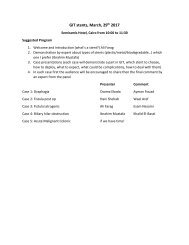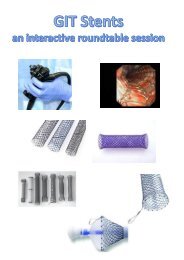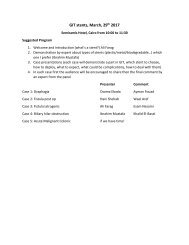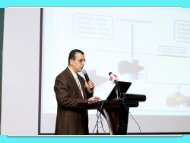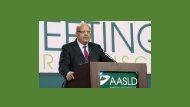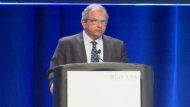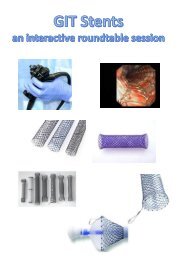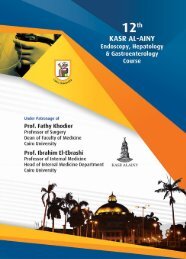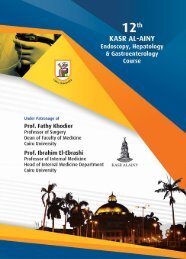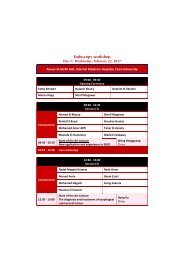HCC: what s new?
Prof. Ashraf Omer
Prof. Ashraf Omer
You also want an ePaper? Increase the reach of your titles
YUMPU automatically turns print PDFs into web optimized ePapers that Google loves.
<strong>HCC</strong>: <strong>what</strong> s <strong>new</strong><br />
Ashraf Omar<br />
Prof of Hepatology and<br />
Endemic Medicine<br />
Cairo University<br />
Secretary General of ESLC
Agenda: AASLD 2016<br />
I. Is There an Increased Risk of Cancer After<br />
Taking Direct-Acting Antiviral Medication?<br />
II. Genetic associatiation with <strong>HCC</strong><br />
development after HCV eradication<br />
III. Oral zinc supplementation and risk of<br />
hepatocellular carcinoma development<br />
IV. Regorafenib a New systemic therapy.<br />
V. Immunotherapy
Abstract #175<br />
The impact of sustained virological response to<br />
HCV infection on long term risk of hepatocellular<br />
carcinoma: The BC Hepatitis Testers Cohort<br />
Naveed Z. Janjua 1,2 , Mei Y. Chong 1 , Margot E. Kuo 1 ,<br />
Amanda Yu 1 , Hasina Samji 1 , Zahid Butt 1,2 , Maria Alvarez 1 , Darrel Cook 1 ,<br />
Jason Wong 1,2 , Ryan Woods 3 , Mark Tyndall 1,2 , Morris Sherman 4 ,<br />
Eric M. Yoshida 2 , Mel Krajden 1,2 ;<br />
1. BC Centre for Disease Control,Vancouver, BC, Canada;<br />
2. University of British Columbia, Vancouver, BC, Canada;<br />
3. BC Cancer Agency, Vancouver, BC, Canada;<br />
4. Medicine, University of Toronto, Toronto, ON, Canada<br />
4
Background<br />
• The risk of hepatocellular carcinoma(<strong>HCC</strong>) post HCV cure is<br />
not well-established for the North American population.<br />
• We assessed the effect of sustained virologic<br />
response(SVR) on the risk of <strong>HCC</strong> among a large population<br />
based cohort in Canada.<br />
Janjua N, et al. Abstract #175, AASLD 2016.<br />
13<br />
5
Methods<br />
• Cohort includes ~1.5 million individuals tested for HCV<br />
between 1990–2013, linked with data on medical visits,<br />
hospitalizations, cancers, prescription drugs and mortality.<br />
• Patients who received IFN based treatments were followed<br />
from the end of last treatment to <strong>HCC</strong> occurrence, death or<br />
December 31, 2012.<br />
• Examined <strong>HCC</strong> risk among those who did and did not<br />
achieve SVR using cumulative incidence function and<br />
multivariable Cox proportional hazard models.<br />
• 8147 patients initiated treatment and 57% achieved SVR.<br />
• Median follow up: 5.6 yr (range: 0.5-12.9)<br />
Janjua N, et al. Abstract #175, AASLD 2016.<br />
6
SVR Substantially Reduces, But Does Not<br />
Eliminate, the Risk of <strong>HCC</strong><br />
• <strong>HCC</strong> incidence rate (IR) was<br />
1.1/1000 person-yr (PY) in<br />
the SVR and 7.2/1000 PY in<br />
the no-SVR groups.<br />
• The IR was higher among<br />
those with cirrhosis at<br />
treatment (SVR: 6.4, no-<br />
SVR: 21.0/1000 PY).<br />
• In those with SVR, cirrhosis<br />
(HR=3.16), older age (50-59<br />
yr: HR=4.73; 60+yr:<br />
HR=5.44 vs. ≤49 yr), and<br />
being male (HR=3.3) were<br />
associated with higher <strong>HCC</strong><br />
risk.<br />
Janjua N, et al. Abstract #175, AASLD 2016.<br />
7
SVR Substantially Reduces, But Does Not<br />
Eliminate, the Risk of <strong>HCC</strong><br />
• <strong>HCC</strong> incidence rate (IR) was<br />
1.1/1000 person-yr (PY) in<br />
the SVR and 7.2/1000 PY in<br />
the no-SVR groups.<br />
• The IR was higher among<br />
those with cirrhosis at<br />
treatment (SVR: 6.4, no-<br />
SVR: 21.0/1000 PY).<br />
• In those with SVR, cirrhosis<br />
(HR=3.16), older age (50-59<br />
yr: HR=4.73; 60+yr:<br />
HR=5.44 vs. ≤49 yr), and<br />
being male (HR=3.3) were<br />
associated with higher <strong>HCC</strong><br />
risk.<br />
Is There an Increased Risk of<br />
Cancer After Taking Direct-Acting<br />
Antiviral Medication?<br />
Janjua N, et al. Abstract #175, AASLD 2016.<br />
8
Potential explanation
Potential explanation
Conclusion<br />
• Incidence of d novo <strong>HCC</strong> is higher than expected after DAAs<br />
• No significant reduction of <strong>HCC</strong> incidence following DAA<br />
therapy in short term follow up<br />
• If DAA – therapy started shortly after treatment of <strong>HCC</strong> risk<br />
recurrence may be increased.<br />
• No pharmacological prevention of <strong>HCC</strong> even with successful<br />
antiviral therapy<br />
• It is mandatory that patients treated with DAAs with<br />
advanced liver disease should continue to be monitored for<br />
<strong>HCC</strong>.
NEED<br />
• LONG TERM FOLLOWUP AFTER SVR<br />
• REAL WORLD REGISTRIES<br />
• MECHANISMS
Abstarct # LB-21<br />
• Genome-wide association study identifies a TLL1<br />
variant associated with development of hepatocellular<br />
carcinoma after eradication of hepatitis C virus<br />
• Y. Tanaka, K. Matsuura, Department of Virology & Liver Unit, Nagoya City<br />
University Graduate School of Medical Sciences, Nagoya, JAPAN|K. Matsuura,<br />
Department of Gastroenterology and Metabolism, Nagoya City University<br />
Graduate School of Medical Sciences, Nagoya, JAPAN|H. Sawai, K. Tokunaga,<br />
Department of Human Genetics, Graduate School of Medicine, The University of<br />
Tokyo, Tokyo, JAPAN|K. Ikeo, Center for Information Biology, National Institute<br />
of Genetics, Mishima, JAPAN|A. Komori, Clinical Research Center, National<br />
Nagasaki Medical Center, Omura, JAPAN|H. Yoshiji, Third Department of<br />
Internal Medicine, Nara Medical University, Kashihara, JAPAN|N. Sakamoto,<br />
Department of Internal Medicine, Hokkaido University Graduate School of<br />
Medicine, Sapporo, JAPAN|Y. Asahina, Department of Gastroenterology and<br />
Hepatology, Tokyo Medical and Dental University, Tokyo, JAPAN|M. Kurosaki,<br />
Division of Gastroenterology and Hepatology, Musashino Red Cross Hospital,<br />
Musashino, JAPAN|N. Kawada, Department of Hepatology, Graduate School of<br />
Medicine, Osaka City University, Osaka, JAPAN|M. Honda, Department of<br />
Gastroenterology, Kanazawa University Graduate School of Medicine,<br />
Kanazawa, JAPAN|
Bakground & Aim<br />
• The risk of developing hepatocellular carcinoma (<strong>HCC</strong>) is<br />
not completely abrogated after eradication of hepatitis C<br />
virus (HCV) by anti-viral agents.<br />
• Aimed is to identify host genetic variation associated with<br />
the development of <strong>HCC</strong> after SVR in chronic HCV patients.
Methods<br />
456 Japanese patients who achieved SVR by interferonbased<br />
therapy and either developed <strong>HCC</strong> at ≥ 1 year after the<br />
end of treatment (EOT) (n=123) or did not develop <strong>HCC</strong> for ≥<br />
5 years after the EOT (n=333), and conducted GWAS in these<br />
two groups. then carried out a replication analysis of 79<br />
candidate single nucleotide polymorphisms (SNPs) in an<br />
independent set consisting of 130 <strong>HCC</strong> and 356 non-<strong>HCC</strong><br />
patients.
Results<br />
• SNP rs17047200, located within the intron of TLL1 on chromosome 4,<br />
showed a strong association with developing <strong>HCC</strong> at a genome-wide<br />
level of significance when the results of the GWAS and the replication<br />
cohort were combined (odds ratio = 2.37, P = 2.66 × 10-8).<br />
• The cumulative incidence of <strong>HCC</strong> up to 10 years after the EOT was<br />
significantly higher in patients with rs17047200 AT/TT<br />
.<br />
• Multivariate analysis showed that rs17047200 AT/TT was an<br />
independent risk factor for developing <strong>HCC</strong> (hazard ratio = 1.86, P =<br />
0.002) in addition to male gender, older age, lower platelet count and<br />
albumin level, and higher post-treatment α-fetoprotein level<br />
• Combining the rs17047200 genotype with other factors ,propose<br />
different prediction models for <strong>HCC</strong> development in patients with mild or<br />
advanced hepatic fibrosis.
Conclusion<br />
• TLL1 may contribute to <strong>HCC</strong> development mainly via<br />
hepatic fibrogenesis, and suggest that genetic testing for the<br />
TLL1 SNP would be useful for implementing personalized<br />
surveillance of <strong>HCC</strong> after SVR has been achieved
174. Oral zinc supplementation improves liver<br />
function and decreases the risk of hepatocellular<br />
carcinoma development<br />
Atsushi Hosui ; Naoki Hiramatsu Gastroenterology and<br />
Hepatology, Osaka-Rosai Hospital, Sakai, Osaka, JAPAN|
Backgrounds and Aim<br />
• Zinc plays a pivotal role in various zinc enzymes, resulting in<br />
maintenance of liver function and decrease of reactive<br />
oxygen species. Patients with chronic liver diseases (CLD)<br />
have usually lower concentration of zinc, which decreases<br />
along with progression of liver fibrosis whether zinc<br />
supplementation improves liver function and the risk of<br />
hepatocellular carcinoma (<strong>HCC</strong>) development
Patients and Methods<br />
• Two hundred forty patients with CLD who had received zinc<br />
preparation (Zn group: 192 cases) at least for 6 months, or<br />
never received (no treatment group: 48 cases) were<br />
retrospectively analyzed in this study.<br />
• Zn group was divided into 4 groups by Zn concentration at 6<br />
months after the start of Zn treatment<br />
• (less than 50 μg/dl (G1), 50-69 μg/dl (G2), 70-89 μg/dl<br />
(G3), and not less than 90 μg/dl (G4)).<br />
• Liver function and the number of event (death, development<br />
of liver cancer, and appearance of liver failure) were<br />
evaluated at least every 6 months.<br />
• The Log-rank test was used to assess the cumulative<br />
incidence rates of event and <strong>HCC</strong> development
Results<br />
• The mean follow-up period was 47.2±23.2 months.<br />
• Liver function significantly deteriorated in the no treatment group<br />
while no significant change was observed in the Zn group .<br />
• The cumulative incidence rates of events at 3 years were 31.8%<br />
in the no treatment group, vs 11.9% in the Zn group.<br />
• The incidence rate of <strong>HCC</strong> at 3 years was lower in the Zn group<br />
(7.9%) than in the no treatment group (25.4%).<br />
• <strong>HCC</strong> was significantly suppressed in patients with Zn<br />
concentration ≧70 μg/dl (G3/G4 groups).
Conclusion<br />
• Zn concentration can be related with the progression of liver<br />
disease and <strong>HCC</strong> development in patients with CLD.<br />
• Oral zinc supplementation was suggested to be effective for<br />
maintenance of liver function and suppression for <strong>HCC</strong><br />
development
NEW SYSTEMIC THERAPTY
Regorafenib<br />
• Oral multi-kinase inhibitor which targets angiogenic, stromal<br />
and oncogenic receptor tyrosine kinase (RTK).<br />
• Shows anti-angiogenic activity due to its dual targeted<br />
VEGFR2-TIE2 tyrosine kinase inhibition.<br />
• Since 2009 it was studied as a potential treatment option in<br />
multiple tumor types.<br />
• By 2015 it had 2 US approvals for advanced cancers.
RESORCE: Regorafenib in <strong>HCC</strong> After<br />
Progression on Sorafenib<br />
• Phase III, randomized, double-blind trial<br />
Pts with BCLC stage<br />
B or C <strong>HCC</strong>;<br />
documented PD on<br />
sorafenib ≥ 20 days<br />
at ≥ 400 mg/day;<br />
Child-Pugh A liver<br />
function;<br />
ECOG PS 0-1<br />
(N = 573)<br />
Randomized 2:1<br />
Regorafenib + BSC<br />
160 mg PO daily Wks 1-3<br />
(n = 379)<br />
Placebo + BSC<br />
PO daily Wks 1-3<br />
(n = 194)<br />
4-wk cycles<br />
• Primary endpoint: OS (ITT) Secondary endpoints: PFS,<br />
TTP, RR, DCR<br />
All pts treated<br />
until PD,<br />
death, or<br />
unacceptable<br />
toxicity<br />
Bruix J, et al. ESMO GI 2016. Abstract LBA-03.
RESORCE: Efficacy<br />
Endpoint<br />
Regorafenib<br />
(n = 379)<br />
*HR 0.44; 95% CI: 0.36-0.55; P < .001; † P = .005<br />
Placebo<br />
(n = 194)<br />
Median OS, mos 10.6 7.8<br />
Median PFS,<br />
mos<br />
3.1 1.5<br />
Median TTP 3.2* 1.5*<br />
ORR, % 10.6 † 4.1 †<br />
• 38% reduction in risk of death (HR: 0.62; 95% CI: 0.50-0.78;<br />
P < .001)<br />
• 54% reduction in risk of progression or death (HR: 0.46;<br />
95% CI: 0.37-0.56; P < .001)<br />
• DCR (CR + PR + SD): 65.2% vs 36.1% (P < .001)<br />
Bruix J, et al. ESMO GI 2016. Abstract LBA-03
RESORCE: Safety<br />
AE, %<br />
Regorafenib<br />
(n = 379)<br />
Placebo<br />
(n = 194)<br />
Any ≥ grade 3 AE 79.7 58.5<br />
Hypertension 15.2 4.7<br />
Hand–foot syndrome 12.6 0.5<br />
Fatigue 9.1 4.7<br />
Diarrhea 3.2 0<br />
Dose modifications due<br />
to AEs<br />
Deaths occurring ≤ 30<br />
days after last dose<br />
68.2 31.1<br />
13.4 19.7<br />
Bruix J, et al. ESMO GI 2016. Abstract LBA-03<br />
Slide credit: clinicaloptions.com
Immunotherapy in <strong>HCC</strong>
IMMUNE SYSTEM FUNCTION AND IMMUNE<br />
RESPONSE<br />
<br />
<br />
<br />
<br />
Nonspecific<br />
First line of defense<br />
WBCs (natural<br />
killer cells,<br />
neutrophils)<br />
Activation of<br />
adaptive response<br />
Identify and destroy foreign or abnormal cells in the body<br />
Innate Immunity<br />
Macrophage<br />
Natural<br />
killer cell<br />
Complement<br />
protein<br />
Dendritic cell<br />
Basophil<br />
Eosinophil<br />
Neutrophil<br />
Mast cell<br />
Adaptive Immunity<br />
λδ T-cell<br />
Natural<br />
killer T-cell<br />
Granulocytes<br />
B-cell<br />
Antibodies<br />
CD4+<br />
T-cell<br />
T-cell<br />
CD8+<br />
T-cell<br />
<br />
<br />
<br />
<br />
<br />
Specific<br />
Adapts specifically<br />
to diverse stimuli<br />
B-cell antibody<br />
production<br />
T-cell stimulation<br />
Memory functions<br />
Immune surveillance:<br />
Involves both innate and adaptive immune mechanisms<br />
Goal of immunotherapy for cancer: to “educate and liberate” underlying anticancer<br />
immune responses<br />
Ja<strong>new</strong>ay CA Jr, et al. Immunobiology: the immune system in health and<br />
disease. 2001.
Discovery of<br />
dendritic cell<br />
HISTORY OF CANCER IMMUNOTHERAPY:<br />
KEY MILESTONES<br />
Tumor-specific<br />
monoclonal Abs<br />
Adoptive T-cell<br />
immunotherapy<br />
IFN-α as adjuvant<br />
therapy for melanoma<br />
BCG<br />
approved<br />
for bladder<br />
cancer<br />
Discovery of checkpoint<br />
inhibitors<br />
First immunotherapy<br />
approved for prostate<br />
cancer (sipuleucel-T)<br />
Pembrolizumab and<br />
nivolumab approved for<br />
advanced melanoma<br />
Atezolizumab approved<br />
for advanced UC and<br />
metastatic NSCLC<br />
Nivolumab<br />
approved for<br />
RCC<br />
Nivolumab<br />
approved for<br />
HL<br />
1970s 1980s 1990s 2000s 2011 2014 2015<br />
2016<br />
Immune component<br />
to spontaneous<br />
regressions in<br />
melanoma<br />
IL-2 approved<br />
for RCC and<br />
melanoma (US)<br />
First tumor-associated antigen<br />
cloned (MAGE-1)<br />
First checkpoint<br />
inhibitor (ipilimumab)<br />
approved for advanced<br />
melanoma<br />
Nivolumab<br />
approved for<br />
NSCLC<br />
Pembrolizumab<br />
approved for<br />
PD-L1+ NSCLC<br />
Pembrolizumab<br />
approved for<br />
HNSCC<br />
References in slidenotes.
Abstract # LB-10.<br />
Nivolumab (Nivo) in Patients (Pts) With<br />
Advanced Hepatocellular Carcinoma<br />
(<strong>HCC</strong>): the CheckMate 040 Study<br />
• Melero, B. Sangro, Clinica Universidad de Navarra, Pamplona,<br />
SPAIN|T. Yau, W. Yeo, Chinese University of Hong Kong, Hong Kong,<br />
CHINA|C. Hsu, National Taiwan University Hospital, Taipei, TAIWAN|M.<br />
Kudo, Kinki University School of Medicine, Osaka, JAPAN|T.S. Crocenzi,<br />
Providence Cancer Center, Portland, Oregon, UNITED STATES|T. Kim,<br />
Seoul National University Hospital, Seoul, KOREA (THE REPUBLIC<br />
OF)|S. Choo, National Cancer Center, Singapore, SINGAPORE|J.<br />
Trojan, Goethe University, Frankfurt, GERMANY|T. Meyer, Royal Free<br />
Hospital, London, UNITED KINGDOM|T. Welling, University of Michigan<br />
School of Medicine, Ann Arbor, Michigan, UNITED STATES|A. Chopra,<br />
Johns Hopkins Singapore International Medical Centre, Singapore,<br />
SINGAPORE|J. Anderson, C. Delacruz, L. Lang, J. Neely, H. Tang,<br />
Bristol-Myers Squibb, Princeton, New Jersey, UNITED STATES|A.B. El-<br />
Khoueiry, University of Southern California Norris Comprehensive<br />
Cancer Center, Los Angeles, California, UNITED STATES|
Background<br />
• For pts with advanced <strong>HCC</strong>, standard-of-care therapy with<br />
sorafenib has limited benefit and those who progress have<br />
few effective treatment options.<br />
• Nivo is a fully human IgG4 monoclonal antibody inhibitor of<br />
the programmed death-1 (PD-1) receptor that provides<br />
survival benefit in multiple malignancies.<br />
• Safety, tolerability, and preliminary efficacy of nivo in pts with<br />
advanced <strong>HCC</strong> in the CheckMate 040 trial
CHECKMATE-040: ASSESSING NIVOLUMAB IN<br />
PTS WITH ADVANCED <strong>HCC</strong><br />
Phase I/II dose escalation study in advanced <strong>HCC</strong><br />
Uninfected pts:<br />
sorafenib<br />
progressors<br />
(n = 58)<br />
sorafenib naive<br />
(n = 51)<br />
HCV-infected<br />
pts (n = 51)<br />
HBV-infected<br />
pts (n = 51)<br />
3 + 3 Dose-Escalation Phase<br />
Nivolumab 0.1-10 mg/kg<br />
Q2W for up to 2 yrs<br />
(n = 23)<br />
Nivolumab 0.3-10 mg/kg<br />
Q2W for up to 2 yrs<br />
(n = 10)<br />
Nivolumab 0.1-10 mg/kg<br />
Q2W for up to 2 yrs<br />
(n = 15)<br />
Expansion Phase<br />
Nivolumab 3 mg/kg<br />
Q2W for up to 2 yrs<br />
(n = 112)<br />
Nivolumab 3 mg/kg<br />
Q2W for up to 2 yrs<br />
(n = 51)<br />
Nivolumab 3 mg/kg<br />
Q2W for up to 2 yrs<br />
(n = 51)<br />
El Khoueiry A, et al. ASCO 2016. Abstract 4012.<br />
Sangro, et al. ASCO 2016. Abstract 4078.
Proportion Surviving<br />
NIVOLUMAB IN <strong>HCC</strong> (CHECKMATE-040): OS BY<br />
PRIOR SORAFENIB IN ESCALATION COHORT<br />
OS similar among sorafenib-naive and sorafenib-treated<br />
pts<br />
1.0<br />
0.8<br />
0.6<br />
0.4<br />
Group Died/Treated Median (95% CI)<br />
Sorafenib naive 7/11 14.1 (3.2-28.6)<br />
Sorafenib treated 22/37 15.0 (5.0-18.9)<br />
0.2<br />
0<br />
Naive Treate<br />
d<br />
0 3 6 9 12 15 18 21 24 27 30 33<br />
Mos Since First Dose<br />
El Khoueiry A, et al. ASCO 2016. Abstract 4012.
CHECKMATE-459: NIVOLUMAB VS SORAFENIB AS<br />
FIRST-LINE TREATMENT IN ADVANCED <strong>HCC</strong><br />
Advanced <strong>HCC</strong>; no<br />
prior systemic<br />
therapy; not eligible<br />
for/progressed after<br />
locoregional<br />
therapy; C-P A;<br />
ECOG PS 0-1<br />
(planned N = 726)<br />
Randomized, open-label, multicenter phase III trial<br />
Stratified by etiology, vascular invasion and/or<br />
extrahepatic spread, and geography<br />
Nivolumab<br />
30 min IV Q2W<br />
Sorafenib<br />
PO BID<br />
All pts treated<br />
until PD,<br />
unacceptable<br />
toxicity, or<br />
withdrawal of<br />
consent<br />
*Nonviral <strong>HCC</strong>, HBV-<strong>HCC</strong> (HBV infection resolved or controlled),<br />
or HCV-<strong>HCC</strong> (resolved or active HCV infection)<br />
Primary endpoint: time to progression, OS<br />
Secondary endpoints: ORR, PFS, PD-L1 expression<br />
Sangro B, et al. ASCO 2016. Abstract TPS4147.<br />
ClinicalTrials.gov. NCT02576509.
• Conclusions:<br />
• Nivo had a manageable safety profile and provided durable<br />
responses in pts with advanced <strong>HCC</strong> irrespective of infection<br />
status.<br />
• OS was encouraging<br />
• Notable disease stabilization was observed.<br />
• Limited antiviral activity was reported in HCV or HBV<br />
infected pts.<br />
• Results support continued investigation of Nivo in advanced<br />
<strong>HCC</strong>
Thank<br />
You<br />
abdelazizashraf@hotmail.com




